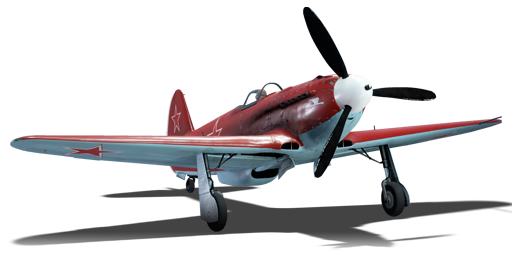



The Yakovlev Yak-3P is the second variant of the Yak-3 fighter aircraft family. The Yak-3P, which entered service in 1945, was the most common Yak-3 variant. The initial variant of the Yak-3 was armed with one 20 mm ShVAK cannon and two 12.7mm Berezin UB heavy machine guns; the Yak-3P features serious improvements in firepower. It was equipped with three 20 mm Berezin B-20 cannons (one in M modification and two in S modification), significantly increasing its combat efficiency and turning it into an even more formidable air-to-air fighter aircraft. Production began after World War II, and a total of 596 aircraft were manufactured, but none were ever deployed in battle. The three-cannon armament was 11 kg less than the standard Yak-3, and the one-second burst mass of 3.52 kg was heavier than most of its contemporary counterparts.
Introduced in Update 1.35, the Yak-3P is one of the best Yak-3 variants produced for the Soviet Air Force. It can easily shred apart any aircraft with a single hit thanks to its three 20 mm Berezin B-20 cannons. Experienced pilots will be thrilled to get their hands on such a powerful plane, and skilful playing can easily gain players several kills in combat. The Yak-3P is one of the strongest fighter aircraft in its rank, with excellent manoeuvrability, powerful armament, and a high-top speed. It does, however, have the classic drawback of all Soviet Yak fighter aircraft: comparatively poor performance over 3,000 metres. This, combined with the wooden construction of its wing tips and control surface compression above 600 km/h, makes it unsuitable for high-speed diving during combat.
flaps
flaps
flaps
brake
| Belt | Belt filling | Armor penetration (mm) at a distance: | |||||
|---|---|---|---|---|---|---|---|
| 10 m | 100 m | 500 m | 1000 m | 1500 m | 2000 m | ||
| FI-T/AP-I | 28 | 24 | 14 | 7 | 4 | 2 | |
| FI-T/HEF/AP-I/FI-T | 28 | 24 | 14 | 7 | 4 | 2 | |
| HEF/FI-T/AP-I | 28 | 24 | 14 | 7 | 4 | 2 | |
| FI-T/FI-T/FI-T | 3 | 3 | 3 | 3 | 3 | 3 | |
| AP-I/FI-T/AP-I/AP-I | 28 | 24 | 14 | 7 | 4 | 2 | |
| AP-I/HEF/HEF/FI | 28 | 24 | 14 | 7 | 4 | 2 | |
| Belt | Belt filling | Armor penetration (mm) at a distance: | |||||
|---|---|---|---|---|---|---|---|
| 10 m | 100 m | 500 m | 1000 m | 1500 m | 2000 m | ||
| FI-T/AP-I | 28 | 24 | 14 | 7 | 4 | 2 | |
| FI-T/HEF/AP-I/FI-T | 28 | 24 | 14 | 7 | 4 | 2 | |
| HEF/FI-T/AP-I | 28 | 24 | 14 | 7 | 4 | 2 | |
| FI-T/FI-T/FI-T | 3 | 3 | 3 | 3 | 3 | 3 | |
| AP-I/FI-T/AP-I/AP-I | 28 | 24 | 14 | 7 | 4 | 2 | |
| AP-I/HEF/HEF/FI | 28 | 24 | 14 | 7 | 4 | 2 | |












Flight performance | |
|---|---|
Survivability |
|---|
Weaponry |
|---|